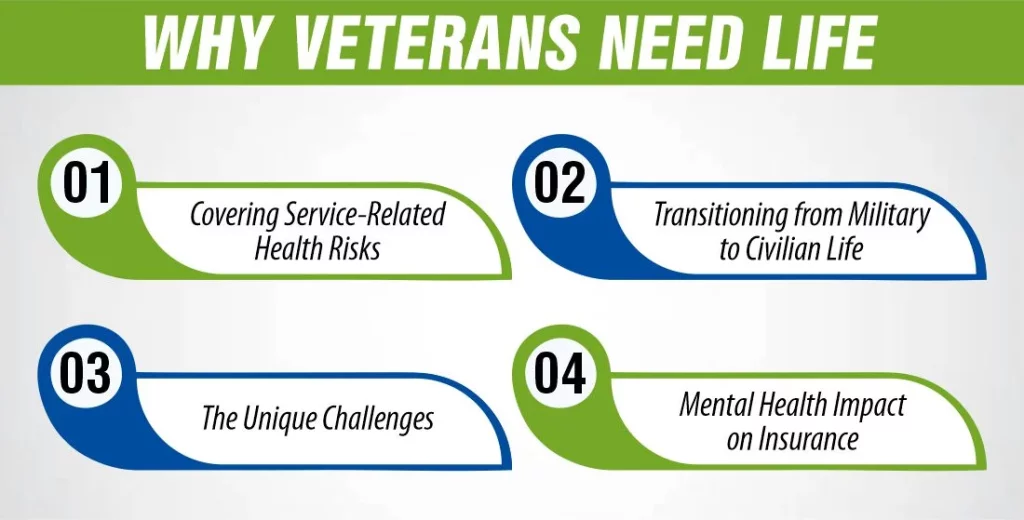Are you a veteran wondering how to provide financial security for your loved ones even after your military service has ended? Life insurance for veterans can be the answer. But which type of policy suits your unique needs and circumstances?
Life insurance, a critical aspect of financial planning for most, takes on an added layer of complexity and urgency for those who have served in the military. Veterans face distinct challenges and needs shaped by their service experiences and the adjustment to life after service.
In this comprehensive guide, we’ll explore the world of life insurance veterans and help you navigate the various options, ensuring you make an informed decision to protect your family’s future. So, veterans, are you ready to discover the best way to safeguard your loved ones when duty calls?

Why Veterans Need Life?
Insurance Financial Safety Net for Families Veterans often provide the primary source of income for their families. Life Insurance for Veterans ensures their families are financially secure during their untimely passing.
- Covering Service-Related Health Risks
Military service exposes individuals to unique health risks, which might result in long-term health complications. Life insurance offers financial protection against these risks.
- Transitioning from Military to Civilian Life
The shift from military to civilian life can bring financial uncertainties. Life insurance provides stability during this transition.
- The Unique Challenges
Veterans Face Health-Related Underwriting Challenges Service-related injuries or conditions can lead to higher insurance premiums or even disqualification from standard policies.
- Mental Health Impact on Insurance
Issues like PTSD, prevalent among veterans, can affect life insurance eligibility and costs.
- Understanding Military vs. Civilian Insurance
Transitioning from military-provided insurance to civilian policies can be complex and confusing for many veterans.
- Age and Employment Transition Factors
Veterans often seek life insurance at an older age or during employment transitions, impacting their insurance options and premiums.
- Knowledge and Awareness Gaps
A significant challenge is the lack of awareness and understanding about the importance of life insurance and the options available to veterans.
Life Insurance Options for Veterans
Here are some options related to Life Insurance for Veterans:
1- Servicemembers’ Group Life Insurance (SGLI)
SGLI is the life insurance program available to active-duty service members and members of the Reserves and National Guard. Key points to consider:
- Automatic Coverage: Service members are automatically enrolled in SGLI with up to $400,000 coverage.
- Low Premiums: SGLI premiums are generally very affordable, making it an attractive option.
- Conversion Option: Veterans can convert their SGLI coverage to Veterans Group Life Insurance (VGLI) upon leaving the military.
- Ensuring Debt and Expense Coverage: Veterans may leave debts or final expenses behind. Life insurance helps manage these financial obligations, easing the burden on families.
2- Veterans Group Life Insurance (VGLI)
VGLI is designed for veterans who want to continue their life insurance coverage after leaving the military. Important aspects to note:
- Guaranteed Acceptance: VGLI offers guaranteed acceptance, meaning veterans are not required to undergo a medical exam.
- overage Amount: The coverage amount can be up to the SGLI you had while in the service.
- Premiums Increase Over Time: VGLI premiums increase with age in five-year increments, potentially making it less cost-effective for older veterans.
3- Private Life Insurance
Private life insurance policies, including term and whole life insurance, are also available to veterans. Key considerations:
- Customization: Private policies allow veterans to tailor coverage to their needs, making them suitable for diverse situations.
- Medical Underwriting: Unlike VGLI, private insurance may require a medical examination and could involve higher premiums for veterans with health issues.
How does Life Insurance for Veterans work?
Life insurance for veterans works in a way that provides financial protection for service members and veterans and their families in the event of the insured veteran’s death. It is designed to offer peace of mind and financial security by paying out a death benefit to the designated beneficiaries upon the insured’s passing. Here’s how life insurance for veterans typically works:
- Servicemembers’ Group Life Insurance (SGLI)
Automatic Enrollment: Active-duty service members are automatically enrolled in SGLI, with coverage typically ranging from $50,000 to a maximum of $400,000.
premiums: SGLI premiums are generally affordable and deducted directly from the service member’s pay.
How Much Does Life Isurance Cost?
Coverage During Service: SGLI provides coverage while the service member is on active duty, in the Reserves, or the National Guard. Coverage continues for up to two years after leaving the military.
Conversion to VGLI: Upon leaving the military, veterans can convert their SGLI coverage to Veterans Group Life Insurance (VGLI) within 120 days of separation, regardless of their health. This option allows veterans to maintain coverage beyond their military service.
- Veterans Group Life Insurance (VGLI)
Guaranteed Acceptance: VGLI offers guaranteed acceptance, meaning veterans do not need a medical exam to qualify. This can be advantageous for veterans with health conditions.
Coverage Amount: The coverage amount can be up to the amount of SGLI the veteran had while in the service, provided they apply within 240 days of leaving the military. After this period, the coverage amount may be limited.
Premiums: VGLI premiums are based on the veteran’s age and increase in five-year increments. While it starts relatively low, premiums can become more expensive as veterans age.
Conversion from SGLI: Converting from SGLI to VGLI is seamless, and veterans can continue their coverage without a gap.
- Private Life Insurance
Customization: Veterans also have the option to purchase private life insurance policies from commercial insurance providers. These policies can be customized to meet the veteran’s and their family’s specific needs and financial goals.
Medical Underwriting: Unlike SGLI and VGLI, private insurance policies may require a medical examination or health questionnaire. The premiums can vary based on the veteran’s health and age.
Diverse Options: Private life insurance policies come in various forms, including term life, whole life, and universal life insurance, allowing veterans to choose the policy type that best suits their circumstances.
Payouts and Beneficiaries:
In the event of the veteran’s death, the designated beneficiaries (often family members or loved ones) receive the death benefit tax-free. Beneficiaries can use the proceeds from the life insurance policy to cover a range of expenses, including funeral costs, mortgage payments, outstanding debts, education expenses, and general living expenses. Veterans can specify multiple beneficiaries and determine how the proceeds are divided among them.
Regular Review:
It’s important for veterans to regularly review their life insurance coverage to ensure it aligns with their current needs and financial situation. Life circumstances, such as marriage, divorce, the birth of children, or changes in financial obligations, can impact the coverage needed. Veterans may also want to consider adjusting their life insurance coverage as they age or experience significant life changes.
In summary, life insurance for veterans offers crucial financial protection to service members and their families. It provides a safety net and peace of mind by ensuring that loved ones are financially supported in the event of the veteran’s passing. Understanding the available options, whether through SGLI, VGLI, or private insurance and regularly reviewing and updating coverage is key to making the most of this important benefit.
Choosing the Right Life Insurance for Veterans
Choosing the right life insurance as a veteran involves careful evaluation of various factors:
- Coverage Needs: Assess your family’s financial requirements, including outstanding debts, future education expenses, and income replacement needs.
- Budget: Consider your budget and affordability, especially when selecting SGLI, VGLI, or private insurance.
- Health Status: Your health and medical history can affect eligibility and private insurance policy premiums.
- Long-Term Goals: Consider your long-term financial goals, such as leaving a legacy or providing for your family’s future.
- Working with an Advisor
Consulting with a qualified financial advisor can be invaluable for veterans in choosing the right life insurance. Advisors can help you:
- Analyse Needs: Advisors can assess your financial situation and determine the appropriate coverage amount and type.
- Compare Options: They can provide a comprehensive comparison of SGLI, VGLI, and private insurance policies.
- Navigate Complexities: Life insurance can be complex, especially for veterans with unique circumstances. Advisors can help you navigate intricacies like service-related disabilities or changes in coverage needs.
What does the life insurance pay for when a veteran dies?
In numerous ways, life insurance can furnish vital financial assistance in the event of the demise of a veteran. The principal benefit provided by the policy is a death benefit, which is a single, consolidated payment to the designated beneficiaries. This payment may cover a range of expenditures, including potentially significant funeral and interment costs. Furthermore, it assists in managing ongoing financial obligations and debts that the veteran may have bequeathed, such as credit card debts, mortgages, and auto loans.
In addition to functioning as a vital means of income replacement, the death benefit guarantees that the veteran’s family can sustain a satisfactory standard of living by providing funds for daily necessities, children’s education, and long-term financial objectives. When a veteran’s pension or other recurrent benefits terminate upon their demise, the proceeds from their life insurance policy can serve as a financial cushion to compensate for the shortfall in income.
Additionally, life insurance policies for veterans with service-connected disabilities or health concerns may encompass supplementary exemptions or benefits that furnish the beneficiaries with supplementary financial assistance. The extensive scope of this coverage demonstrates recognition of the distinct hardships and sacrifices that military personnel and their families must endure.
Conclusion
In conclusion, life insurance for veterans is much more than a financial safeguard; it is a crucial aspect of acknowledging and respecting the unique sacrifices made by those who have served in the military. The challenges veterans face in obtaining life insurance—ranging from health-related issues due to service, and mental health impacts, to the complexities of transitioning from military to civilian policies—underscore the need for tailored insurance solutions and specialized support.
By addressing these specific needs, life insurance becomes a pivotal tool in ensuring that veterans and their families are protected and provided for. It’s a tangible expression of gratitude, offering peace of mind and financial security to those who have dedicated a significant part of their lives to serving their country.

Joyce Espinoza, Expert Life Insurance Agent
Joyce Espinoza is a trusted life insurance agent at mLifeInsurance.com. She’s been in the insurance industry for over ten years, helping people, especially those with special health conditions to find the right coverage. At MLife Insurance, Joyce writes easy-to-understand articles that help readers make smart choices about life insurance. Previously, she worked directly with clients at Mlife Insurance, advising nearly 3,000 of them on life insurance options.




